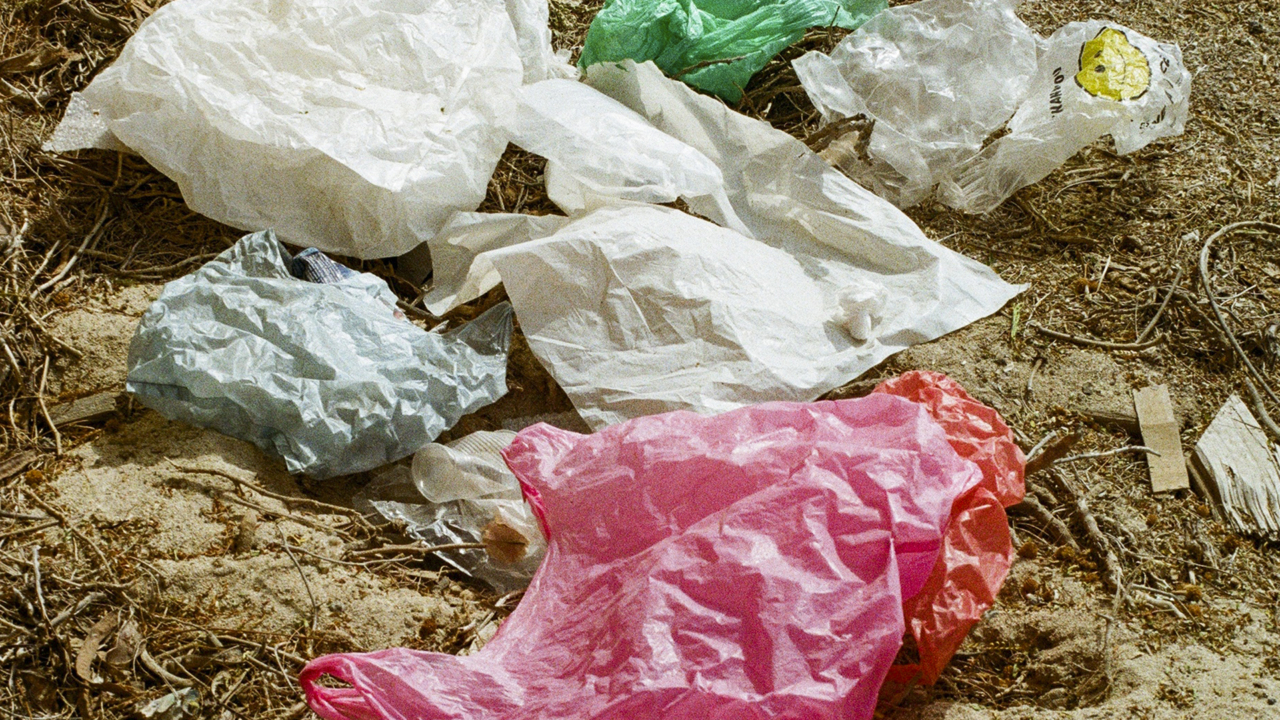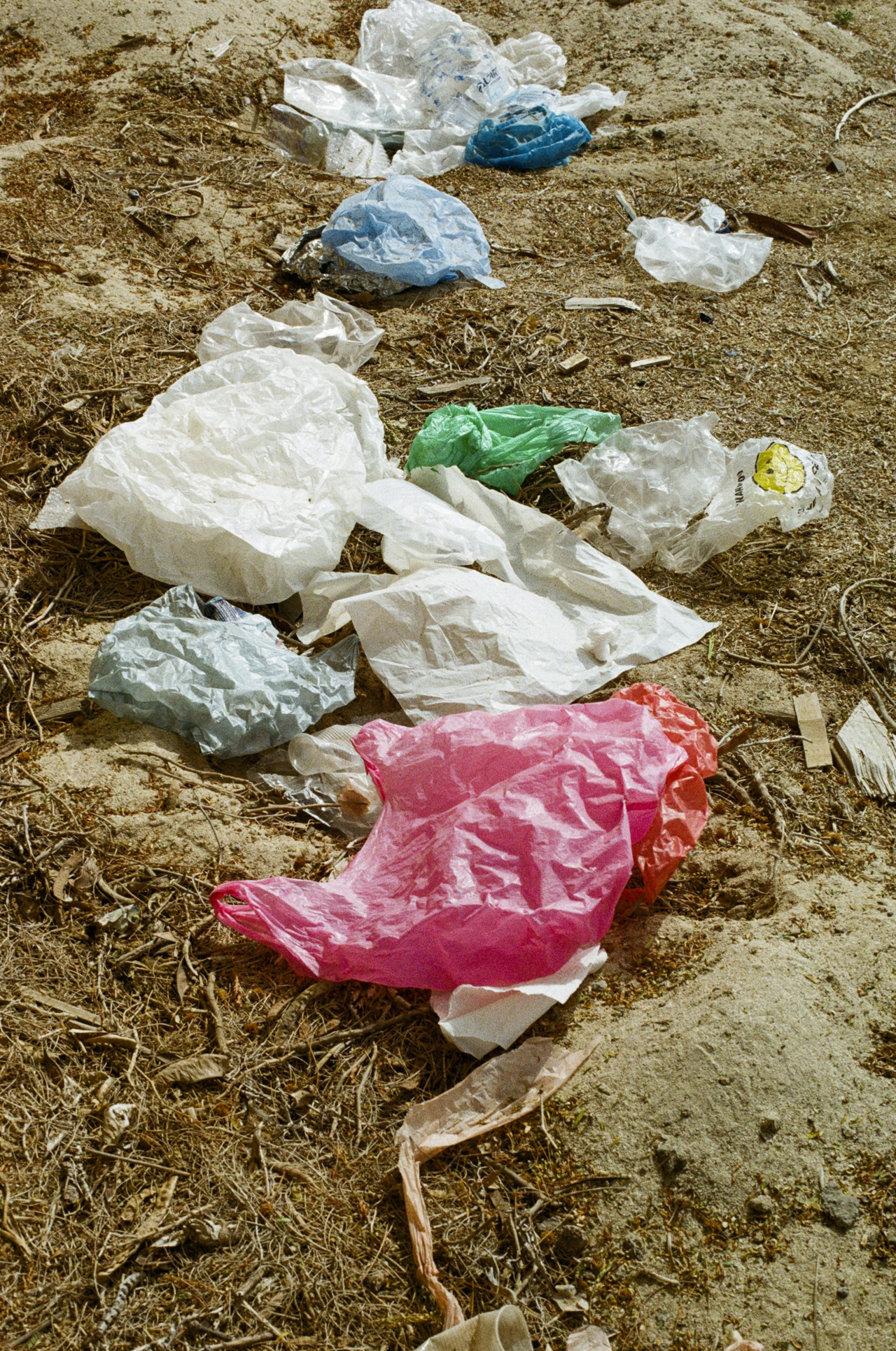

Photograph by Vincent Forstenlechner / Connected Archives
Words by Catherine Tansey
Standing waist high in fetid river water, a handful of people donning waders and elbow-high rubber gloves fish out a congealed mass of plastic bags, used diapers, and single-use laundry detergent satchels from the reeds and bamboo shoots. I watch them from the “river bank,” an interminable mound of takeaway cartons, garbage bags, and IndoMie instant noodle packets that, together with the thick Bali mud, have formed one big solid mass by the sheer force of time. Clutching my collection bag in one hand, I reach down to fill it with handful after handful of waste, the Bali humidity clinging to me like saran wrap. But what is a one-off afternoon excursion for me, is the daily work of the Sungai Watch team.
When French-born siblings and activists Gary, Sam, and Kelly Bencheghib started the nonprofit Sungai Watch in 2020 (sungai means “river” in Bahasa Indonesia), their mission was simple: to reduce the flow of plastic from Bali’s rivers into the ocean. Their newest venture, Sungai Design, which launched earlier this year, aims to solve another issue: what to do with all the waste.
Indonesia is the world’s second-largest plastics polluter after China. As a result of largely inadequate waste management systems, individuals often burn trash or deposit it in illegal landfills—the primary reason why much of it ends up in the archipelago’s waterways. The short-term effects are disastrous. Direct pollution chokes waterways, degrades ocean health, and disrupts industries, like fishing as well as the island’s main economic sector, tourism. But the long-term effects are even worse. Plastic pollutants eventually decompose, forming microplastics and releasing toxic forever chemicals into necessary water sources and marine ecosystems. This excessive waste creates public health risks for communities—human and non-human alike.
View this post on Instagram
The Bencheghibs, who moved to Bali from Paris with their parents when they were young kids, have seen firsthand the deleterious effects of plastic contamination on the island. During the region’s months-long rainy season, torrential downpours flush the island’s rubbish into waterways, which carry it directly into the sea and pollutes Bali’s one-time pristine beaches and waters.
In 2020, the siblings worked with the German-based company Plastic Fischer to prototype a buoyant river barrier and install it in the waterway by their parents’ home. After the first heavy rainfall, they collected 50 kilograms of plastic. They were wise to target rivers: Scientists previously believed that only 10 to 20 rivers worldwide were responsible for the pollution entering the sea by inland waterways, but research published in Science Advances in 2021 put that number closer to 1,000—many of which are in Asia.
As experts in plastic pollution and long-time activists, the siblings readily downplay Sungai Watch’s contribution. “It’s really just a drop in the bucket,” says Kelly Bencheghib. Yet, with over 300 floating river barriers installed and more than 2.3 million kilograms of plastics collected during river cleanups in just four years, Sungai Watch is undeniably a leader of pollution prevention in the region.
The sheer quantity of trash piling up at their seven facilities is what has forced the NGO to find new uses for it and spurred them to secure a new revenue stream. Sungai Watch is largely funded by corporate sponsorships, with some capital coming from grants and scholarships, including $300,000 from the Elevate Prize as a 2024 winner. Still, the business of reducing plastic pollution is an expensive one—to implement Sungai Watch’s village model, which includes 15 barriers, plus the cost of renting a warehouse and hiring a team of 12 people to sort and clean waste, costs $150,000.
“Recycling is not the solution. It’s all about reduction, and we hope to see a drastic reduction in the plastic waste polluting Bali’s rivers.”
Behind Sungai Design is the urgent need to recycle low-value plastics, but also to create a more stable revenue model for Sungai Watch. “People are very generous and we’re grateful for the donor community. We just want to be able to move faster, and having that financial independence would allow that,” says Bencheghib. Sungai Design’s debut furniture piece, the Ombak lounge chair, is composed of 2,000 plastic bags. “We’ve focused on furniture because it’s a bulkier item, and because we saw there was a hole in the market to create a more comfortable upcycled chair as many of them are quite rigid,” says Bencheghib.
Having long audited every single piece of waste they pull from the island, Sungai Watch compiles an annual impact report where they detail the data collected at each of their seven facilities. Their 12-person teams at each facility are split between washing trash and recording details like manufacturer, brand, use-type, and more. Armed with data about the largest polluters (consistently Danone, Wings Surya, and Nestlé among other brands), Sungai Watch lobbies for corporate accountability and government action. They also obtain insight about the best possible future for various types of trash.
“Because we collect a lot of data, we know that plastic bags are the number one item we collect,” says Bencheghib. “There’s no other use for plastic bags currently, as their flimsy build makes it challenging to recycle them.” Set on creating a social enterprise company that upcycled plastic and brought these goods to market but lacking engineering or design backgrounds, the Bencheghibs educated themselves via the open source project Precious Plastic, a resource for individuals and entrepreneurs alike keen on creating recycled plastic goods.
Precious Plastic shares upcycling tutorials, lists databases of others doing the same, hosts community forums, and offers advice on where to purchase materials—and, according to the Bencheghib siblings it was a great place to start despite its focus on recycling rigid plastic. Flexible plastics, which break down more easily, are more difficult not only to recycle but to wash.
“Washing is the most time-intensive step of the entire process,” says Kelly Bencheghib, adding that the team meticulously cleans the bags, shreds them, and then heat-presses them into 1x1m plastic sheets. Next, the team uses CNC machinery, a computer software controlled manufacturing process, to precision-cut the pieces, minimizing offcuts and waste.
View this post on Instagram
Early on, Sungai Watch enlisted Bali-based designer Michael Russek to conceptualize designs made entirely from repurposed plastics. The Ombak lounge chair is the first piece available from the collection. Despite decades of design experience, the work challenged Russek to construct in innovative ways. “A big part of the design was coming up with a chair we could make out of 1x1m sheets, the only size Sungai Design is able to produce right now,” says Russek.
Following the principles of parametric design, which allows a maker to combine 2D pieces to create 3D forms, Russek used CNC machinery to precision cut the pieces and assembled the chair—which is modern and elegant with a slatted build—by sliding the oblong cuts along a steel rod to anchor them in place. But designing for comfort was a challenge. Most recycled plastic furniture on the market is stiff, so Russek turned to design history to glean inspiration for a chair that would be comfortable without cushions.
“I was inspired by mid-century furniture, which has a pitch and angle that’s very specific to that time period.” Russek says. “Even though [they’re] all wood, that perfect pitch and angle mean you don’t feel the weight of being pressed against the hard surface.” To replicate this, Russek purchased a mid-century modern chair, “copied the angle, and just made it modern.”
The Ombak chairs are available in granite black, concrete white, ocean blue, and coral green, and retail for about $900 USD. The high price tag is down to the fact that it takes 30 artisans an entire day to make one chair, and that doesn’t include the labor required to amass the plastic bags from Sungai Watch’s river barriers. Though Sungai Design is targeting high-end customers for now, it is working towards leveraging economies of scale to bring the price down and to make it more accessible.
“If we don’t have any more plastic supplies for us, that’s the goal, and we’ll find another plastic type or material to work with. Showcasing that there are solutions—that is really exciting.”
Additionally, plastic upcycling requires intensive research and development, which means significant startup capital. Like many types of plastic, the Ombak chair isn’t UV-stable, meaning it’s suited for indoor use only. And while Sungai’s chairs have undergone extensive independent testing to ensure safety, widespread concern remains about plastics safety—recycled or otherwise. The University of Gothenburg published a 2023 paper, which concluded that “before recycling can contribute to tackling the plastics pollution crisis, the plastics industry must limit hazardous chemicals.” Another 2023 report from Greenpeace found that recycling plastics can increase toxicity.
And though the Ombak chair is composed of an impressive 2,000 plastic bags, it’s estimated that Indonesia releases 10 billion plastic bags per year. To upcycle a single year’s worth of plastic bags, Sungai Design would have to produce a chair 365 days per year for nearly 14 years. More than any other message, the Bencheghib siblings stressed the urgent need to reduce our consumption.
“Recycling is not the solution. It’s all about reduction, and we hope to see a drastic reduction in the plastic waste [polluting Bali’s rivers],” Bencheghib says. The most immediate advantage of Sungai Watch’s barriers is stemming the flow of pollution, but they hold great power as a data company, too. “It’s also an opportunity to collect information, which allows us to engage in proper conversations about plastic reduction programs, awareness campaigns, and apply pressure to the government to ultimately hold these companies accountable.”
Despite the hurdles of fighting pollution and finding new uses for it in a ceaselessly consumer-driven world, Sungai is encouraged by the interest they’re generating from other NGOs and the design world alike. Since launching Sungai Design in March, the company’s Instagram page has already grown to a quarter of a million followers, and Bencheghib says initiatives and projects from around the globe have reached out to understand how to replicate their model.
If their model becomes obsolete, then even better.“We are advocates for reducing and banning these types of plastics in the first place,” says Bencheghib. “So, if we don’t have any more plastic supplies for us, that’s the goal, and we’ll find another plastic type or material to work with. Showcasing that there are solutions—that is really exciting.”
Fighting Indonesia’s Plastic Pollution One River Barrier at a Time